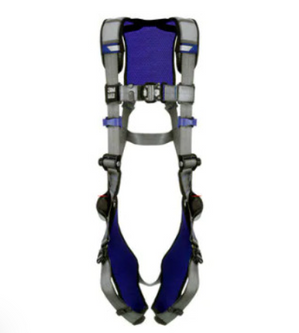Fall Protection in Confined Spaces
In permit required confined spaces, workers are routinely entering areas which were not made with peoples’ comfort or safety in mind. They often have irregular entrances, tight spaces, and dangerous drops. Fall protection for confined space workers has been dramatically improving over the years, but even trained personnel don’t always know the correct configuration of equipment for each work site.
To discuss fall safety in a confined space, we first need to define some of the common terms. By defining the terms, we can better understand how the equipment and practices help keep workers from injury.
Fall Protection, for instance, describes the entire process of protecting workers from the risk of falling. Fall Protection science has come a long way from the early rope tied around the waist. It has evolved over time with testing and product development by scientists, regulators and equipment companies. To see a video of the forces generated by a fall, click here. Fall restraint is one form of fall protection. Fall restraint is any physically limiting process that keeps a person from reaching the drop off. Using this definition, a guardrail that keeps someone from walking off a ledge is fall restraint. Anything that keeps a worker from reaching a falling point can be considered fall restraint. Typically workers in confined space applications where fall protection is required position themselves by attaching a lanyard to their harness so that any fall will be less than a two-foot drop, or they use the lanyard in such a way as to not allow them to reach the precipice at all. The important distinction here is the positioning lanyard is not used as shock absorption to cushion a fall, but to absolutely keep a worker from being able to reach the edge and fall in the first place or to have a fall of less than two feet so the total shock to the body is less severe.
Fall arrest is very different from fall restraint. It involves potentially longer drops, and incorporates technology to limit pressures created by the drop on the body. Fall restraint occurs when a worker has gone over the edge and the fall is stopped in mid-action by a shock absorbing lanyard or self-retracting lifeline (SRL) attached to the worker’s harness. The fall is arrested with the SRL by limiting the length of the fall and therefore the forces generated. With the shock absorbing lanyard, the forces are reduced by allowing the shock to be mitigated by the specially engineered webbing or internal ripstreach materials which slow the drop and thereby reduce the stress on the fallen worker. OSHA provides guidelines for the strength and fall distance limits of SRLs and lanyards. By design these fall protection devices must limit the free-fall distance to two feet or less and must be able handle a load of 3,000 lbs when fully extended. Shock absorbing lanyards that will exceed the two-foot limit must be designed for ripstreach, tearing or deforming. These types of lanyards are specifically constructed to deform when under strain to slow the rate of fall, and must, at their fully extended length, be able to handle a full 5,000 lbs.
Harnesses are used in almost all types of confined space work because safety teams are required to have a method of removing an incapacitated worker in the event of an accident. Harnesses can also be utilized as a fall protection device. But there are wide variations in design depending upon the type of work as well as different levels of quality and comfort. OSHA is willing to call practically any configuration of straps secured around an employee that is meant to evenly distribute the forces generated from a fall over the various strong parts of the body a harness. That leaves wide latitude in terms of comfort. Anyone who is working in a confined space for more than a short period of time will realize that being able to comfortably enter and exit a confined space with the aid of a harness is very important. Certainly anyone working at height where they may be suspended by means of this “configuration of straps” will be able to perform their work better, over a longer period of time, with the correct harness for the particular application. Harnesses must have an attachment point for the fall arrest system located between the shoulder blades on the back of the harness (example). Many harnesses also have additional rings for positioning lanyards to be attached.
A rope-grab is a deceleration device that slows or arrests the rate of fall. A rope grab “follows” a worker as he or she walks and works along the length of the line. In the event of an accident, the rope grab engages and arrests the worker’s fall. Rope grabs do not engage unless pressure is applied, such as in the event of a fall, whereupon the brake will engage limiting the fall.
While all of these items provide fall protection in certain situations, it is the site safety plan combined with the willingness of the workers to follow safety protocols that add up to a safe work environment.
Recent Posts
-
The Best Cold Weather Gloves for Package Handlers and Delivery Drivers | PK Safety
Best Gloves for Package Handlers During the Holiday Season As the holiday season approaches, pa …Nov 11th 2024 -
Why Hi-Vis Winter Work Gear is Essential for Safety During the Cold Months | PK Safety
When temperatures drop and daylight hours shrink, outdoor workers face additional hazards that incre …Oct 31st 2024 -
Self Braking Descender: Advanced Rope Control for Fall Protection | PK Safety
For professionals working at heights, controlled descent is critical. Whether you’re a window cle …Oct 30th 2024





